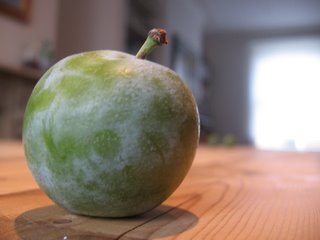
The greengage is a curiously overlooked fruit. I suppose against the big, bold, sumptuously fragranced and summer-coloured stone fruits – the peaches, nectarines, plums and apricots – it doesn’t shout much for itself. It looks small and, well, green… unripe perhaps the uninitiated might think.
But those who overlook this little verdant fruit are missing out. For me, it is one of the best summer fruits, one of the fruits closest to my heart.
We have a greengage tree in my family home, but unfortunately it’s rarely ever borne more than three or four tiny but perfect fruits. It’s feeble effort has marked the greengage in my mind with the anthropomorphic characteristics of a plucky survivor, an under-achiever, a shy, retiring, struggling kind of fruit, unlike the plentiful Victoria and purple plums which rained down from the trees either side of it.
And maybe because the fruit were so rare, it made them all the more precious. Each summer would only provide me with one or two sugar-packed emerald mouthfuls.
Putting all that sentimentality aside though, I truly do think this is a king among fruit. It’s just so packed full of its particular summer taste; so perfect in its balance of sugar and tartness and flavour.
The supermarkets can’t really do it justice, but luckily London is blessed with a multitude of small fruit and veg tradespeople, who man little stands on many busy streets. So just a short walk from the office I can buy half a pound of greengages for 60p, and even if it’s grey and miserable like today, I can stand amidst the grime and bustle of the city and be wrapped up in a little sunshiny world as I pop each little gage straight out of the paper bag and into my mouth.
A little extra information…
The fabulous Wikipedia tells me that:
“The Greengage is an edible drupaceous fruit, a cultivar of the plum, Prunus domestica 'Reine Claude'. It was developed in France from a green-fruited wild plum originally found in Asia Minor. It is identified by its small, oval shape, smooth-textured flesh, and ranging in colour from green to yellow, grown in temperate areas. They are known for their rich, confectionery flavour that cause them to be considered one of the finest dessert plums.
The name 'Reine Claude' is after the Queen-consort of King Francis I of France. "Green Gages" were imported into England from France in 1724 by Sir William Gage, 2nd Baronet of Hengrave, from whom they get their English name. Allegedly, the labels identifying the French plum trees were lost in transit to Gage's home in Bury St Edmunds. Soon after, Greengages were cultivated in the American colonies, even taking a place on the plantations of George Washington and Thomas Jefferson. However, their cultivation in North America has declined significantly since the Eighteenth Century.”


